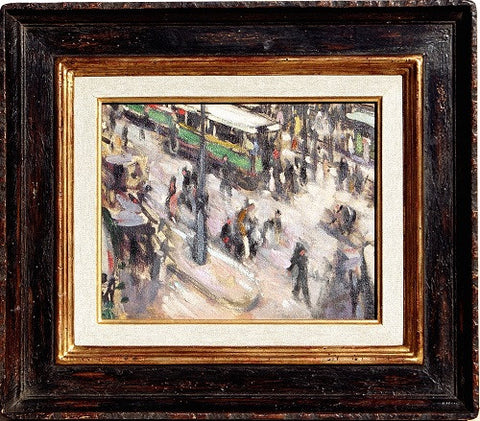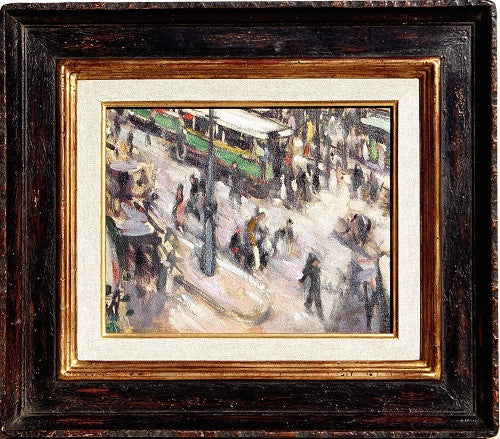

Fontainebleau Fine Art
School of Paris : Attributed to Constantin Korovine (Moscow 1861- 1939 Paris)
$0.00
Call For Location | 203-325-8070
Constantin Korovine is considered to be the first Russian impressionist. He discovered occidental art during his academic training at the Painting Institute of Moscow (1875-1883).
Fascinated by Paris, Korovine made the first of many journeys to the City of Light in 1887. At the time the capital of the arts was a powerful magnet for artists worldwide lured by the career-launching annual Paris Salon and became the breeding ground for the avant-garde that the entire art world today credits as the undisputed birthplace of Modern Art.
The foreign artists who flocked Paris low- rent neighborhoods of Montparnasse and Montmartre, creating real colonies and a mixture of styles and national influences, are united under the banner term of Ecole de Paris (The School of Paris), as a tribute to this purely Parisian Phenomenon.
Korovine later wrote: "Paris was a shock for me Impressionists in them I found everything I was scolded for back home in Moscow".
He settled in the city in 1923, and remained there until his death.
Upon arrival, the artist was mesmerized by the Parisian night scene and street life which became his favorite subject matter, setting up a new genre, as yet little-developed in Russian art, namely urban landscapes or street scenes. At the same time, his highly personal style, based on rough oil sketches, developed into the bolder, freer handling of the medium with which his name has been associated ever since.
The Russian painter is never more fervently Impressionistic than when striving to render his vision of the City boulevards with its people, car and busses, street lights. The artist was dazzled by its vibrancy and he relentlessly tried to capture a fleeting moment (as this is iconic of Impressionism) of the hustle and bustle of the city overflowing with the exuberance of La Belle Epoque (the beautiful period around the 1900's) or Les Ann̩es Folles (the crazy years in the 20's and 30's after WWI).
The artist's street scenes are always executed in situ with subjects captured on the spot, from life painted with a few brief and confident brushstrokes. Very often, Korovine used a high vantage point, placing the viewer at a dominating position to better observe the scene passively without taking part of it. The perspective is deliberately clumsy and the framing/cropping of the scene is tight, increasing the sense of impetuous movement and of rush bursting with life.
Such richly expressive sensory values are inimical to an elaborately finished, complex painting. Hence Korovine‰۪s cultivation of his distinctive sketchy style, refuting the tenets of academic painting, to the displeasure of some of his contemporaries thought to be more finished commented one, to which Korovine replied: I tried, but it silences the music.
There is a strong presumption that the presented piece, an unsigned and preliminary work, was executed by Korovine as it gathers all the emblems of the artist's work:
- The subject matter of a busy Parisian boulevard.
- The same impressionistic brushwork, color palette and use of preliminary sketches made on the spot.
- The iconic high vantage point and characteristic cropping of the composition.
- The back study of a landscape is very similar of those made by Korovine, also a landscape painter.
- The age of the medium and support used for this piece indicates that it was made at the same period as Korovine‰۪s famous Parisian scenes.
Therefore, it is undeniably legitimate to refer to this work as attributed to Constantin Korovine.


Fontainebleau Fine Art
School of Paris : Attributed to Constantin Korovine (Moscow 1861- 1939 Paris)
Constantin Korovine is considered to be the first Russian impressionist. He discovered occidental art during his academic training at the Painting Institute of Moscow (1875-1883).
Fascinated by Paris, Korovine made the first of many journeys to the City of Light in 1887. At the time the capital of the arts was a powerful magnet for artists worldwide lured by the career-launching annual Paris Salon and became the breeding ground for the avant-garde that the entire art world today credits as the undisputed birthplace of Modern Art.
The foreign artists who flocked Paris low- rent neighborhoods of Montparnasse and Montmartre, creating real colonies and a mixture of styles and national influences, are united under the banner term of Ecole de Paris (The School of Paris), as a tribute to this purely Parisian Phenomenon.
Korovine later wrote: "Paris was a shock for me Impressionists in them I found everything I was scolded for back home in Moscow".
He settled in the city in 1923, and remained there until his death.
Upon arrival, the artist was mesmerized by the Parisian night scene and street life which became his favorite subject matter, setting up a new genre, as yet little-developed in Russian art, namely urban landscapes or street scenes. At the same time, his highly personal style, based on rough oil sketches, developed into the bolder, freer handling of the medium with which his name has been associated ever since.
The Russian painter is never more fervently Impressionistic than when striving to render his vision of the City boulevards with its people, car and busses, street lights. The artist was dazzled by its vibrancy and he relentlessly tried to capture a fleeting moment (as this is iconic of Impressionism) of the hustle and bustle of the city overflowing with the exuberance of La Belle Epoque (the beautiful period around the 1900's) or Les Ann̩es Folles (the crazy years in the 20's and 30's after WWI).
The artist's street scenes are always executed in situ with subjects captured on the spot, from life painted with a few brief and confident brushstrokes. Very often, Korovine used a high vantage point, placing the viewer at a dominating position to better observe the scene passively without taking part of it. The perspective is deliberately clumsy and the framing/cropping of the scene is tight, increasing the sense of impetuous movement and of rush bursting with life.
Such richly expressive sensory values are inimical to an elaborately finished, complex painting. Hence Korovine‰۪s cultivation of his distinctive sketchy style, refuting the tenets of academic painting, to the displeasure of some of his contemporaries thought to be more finished commented one, to which Korovine replied: I tried, but it silences the music.
There is a strong presumption that the presented piece, an unsigned and preliminary work, was executed by Korovine as it gathers all the emblems of the artist's work:
- The subject matter of a busy Parisian boulevard.
- The same impressionistic brushwork, color palette and use of preliminary sketches made on the spot.
- The iconic high vantage point and characteristic cropping of the composition.
- The back study of a landscape is very similar of those made by Korovine, also a landscape painter.
- The age of the medium and support used for this piece indicates that it was made at the same period as Korovine‰۪s famous Parisian scenes.
Therefore, it is undeniably legitimate to refer to this work as attributed to Constantin Korovine.



